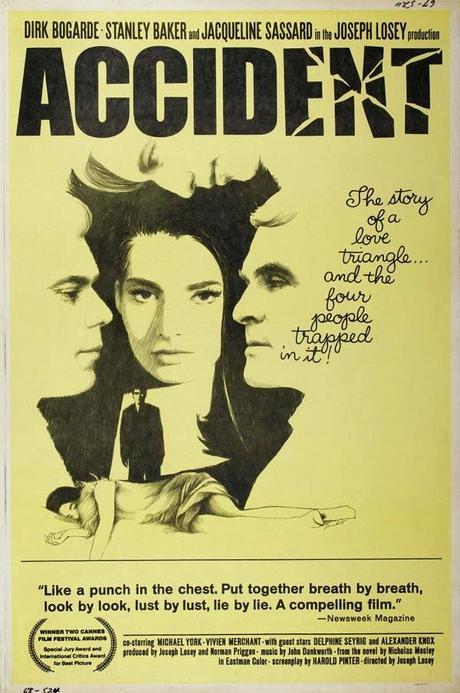 Although he was an American filmmaker from Wisconsin state hounded
by the infamous “McCarthy” Committee (House Un-American Activities Committee)
set up to weed out Leftist sympathisers in Hollywood, most filmgoers today tend
to associate Joseph Losey with British cinema than American/Hollywood cinema.
Losey had in his early career worked with the obviously Leftist playwright
Bertolt Brecht in Germany. Sensing
apathy in the US after being asked to appear before the “McCarthy committee,”
Losey quickly chose to live in the UK rather than “name names” at the socialist
witch-hunt. America’s loss was Britain’s gain.
Although he was an American filmmaker from Wisconsin state hounded
by the infamous “McCarthy” Committee (House Un-American Activities Committee)
set up to weed out Leftist sympathisers in Hollywood, most filmgoers today tend
to associate Joseph Losey with British cinema than American/Hollywood cinema.
Losey had in his early career worked with the obviously Leftist playwright
Bertolt Brecht in Germany. Sensing
apathy in the US after being asked to appear before the “McCarthy committee,”
Losey quickly chose to live in the UK rather than “name names” at the socialist
witch-hunt. America’s loss was Britain’s gain.
Unfortunately, in England, some of Losey’s works were far ahead of its time, especially his three movies made in collaboration with the Nobel Prize winning screenplay-writer Harold Pinter in the evening of Losey’s career. Just as the Polish filmmaker Krzysztof Kieslowski bloomed in his final years as a filmmaker following his association with screenplay-writer and lawyer-politician Krzysztof Piesiewicz, the Losey-Pinter phase produced three remarkable works: The Servant, Accident, and The Go-Between. Losey’s Accident left home audiences in the UK considerably puzzled, but won the Grand Prize of the Jury at the Cannes film festival, while his The Go-Between (1971) picked up the Golden Palm a few years later. Even to this day, only serious cineastes note the understated brilliance of Losey’s Accident —with its myriad details less obvious for a casual viewer.
Joseph Losey’s Accident was the high point of his career and arguably one of the finest and least appreciated British films ever made ranking alongside the British works of Stanley Kubrick. Losey has made great films and very unremarkable films in his career. This critic rates Losey’s Accident as one of the top 100 films ever made globally. The following review attempts to explain the importance of this movie that eluded most audiences when it was made. It is engagingly similar to Michael Haneke’s Caché (Hidden) (2005) both in structure and content, even though the French/Austrian film was made half a century later. Caché, like Accident, pleased the jury at the Cannes film festival and picked up major awards.

Stephen (Bogarde) and Anne (Sassard): Controlled emotions enhanced by the camera angle
The structure of the film. Accident begins and ends with a long static shot of a house without human presence in the foreground. Haneke’s Caché reprises the same long static shot of an apartment in Paris without human beings in front of the camera to begin and end his film. Both films do not use music but natural diagetic sounds for these scenes (recall Hitchcock’s treatment of sound in Rear Window). Of course, in Accident both the long static shots end with the sound of a car crash, which is pivotal to the movie without ever showing the accident as it occurs in close proximity to the house. This is one of the tools that would have irritated audiences used to seeing what it heard on screen. Losey had already achieved a half century ago, the cinematic effect that Haneke perfected recently in Caché. In both films, the closing shots are not merely following the aesthetic structures propounded in Aristotle’s Poetics, but are attempts to urge the viewer to revisit what has been said in the movie earlier.
Both Accident and Caché suggest ideas rather than show/spoon-feed viewpoints of the filmmakers. The viewer is forced to deduce the story; the director does not tell you the full story. Take the example of the final shot in Accident with the brilliant use of sound edit of a similar car crash one heard when the film began. The only difference after you hear the two crashes is that after the first one, the inhabitants of the house come out to investigate. After second crash, there is no apparent interest by the denizens of the house to investigate the sound after second crash sound is heard. Losey and Pinter have a created a masterstroke. The second one is not real but a symbolic statement for us the viewers to employ as a clue to figure out what the filmmakers were stating beyond the obvious. The brilliance of the film in this movie cannot be attributed to the novelist Nicholas Mosley but to the director and the scriptwriter who made the effect so fascinating. (By contrast, this critic has always maintained that in some films. such as Life of Pi (2012), the novelist is the true creator, with much less contribution of the director or the scriptwriter whose contribution is merely to transpose the written ideas effectively on the screen. An ignorant viewer would place the credit for the basic ideas on the wrong shoulders.) Then again both Losey and Haneke combine silence and sudden violent acts with amazing skills—for Losey violence gets distilled into the sound of a breaking twig, for Haneke, it is more graphic and chilling.
The opening and the end of Accident are a delight to study. The opening shot is captured in the night with realistic skies by cinematographer Gerry Fisher as opposed to “day-for-night” tricks that other directors employed with aplomb even decades later. The opening shot is actually filmed at night and the final shot late in the evening under twilight. A difference that the filmmakers want the viewers to note is a toy car left behind by the children on the driveway. The toy car provides a symbolic irony of the car accident that ties together the various strands of the tale about adults. The toy car in its ironic turn has little to do with the movie but “accidentally” and innocently provides a pivot to bring all the elements of the story in perspective.

William, Charley and Stephen (in the backgound): the typical weekend afternoon.
Note the camera angle.
There are personal trivia that add value to the script. Charley reads out from an academic journal “A statistical analysis of sexual intercourse at Colenso University, Milwaukee, showed... that 70% did it in the evening, 29.9% between 2 and 4 in the afternoon and 0.1% during a lecture on Aristotle.” An old professor is quick to quip “I'm surprised to hear that Aristotle is on the syllabus in the State of Wisconsin.” For most viewers it would be just witty banter. Or is it? Please note Losey was from Wisconsin and was a student of philosophy. Was this an exile’s jibe at the US?
Another trivia is that both Pinter (in a small role of a TV producer) and his then real-life wife Vivien Merchant appear in this film. Ironically years later, Merchant divorced Pinter for infidelity just as Stephen was cheating on Rosalind in the film Accident. Bogarde was gay and the film is a wonderful example of his real sexual inclinations, a subtle performance that is less memorable than his overtly gay role in Luchino Visconti’s Death in Venice (1971) based on Thomas Mann’s novel.
The unusual camera angles and the studied silence of the soundtrack, employing John Dankworth’s music only when essential, would have put off most viewers. But the silence talks in Accident. The making of the omelette and the “violent” eating of the omelet brings one closer to the ‘kitchen-sink realism’ that Pinter was famous for detailing. What was spoken had to share time and space with the making of a single dish. That is seminal Losey-Pinter alchemy.

Stephen (Bogarde) and Rosalind (Merchant) (in the background):
underplayed powerful performances
Accident is a great work of cinema, from a great ensemble of actors and talented persons behind the camera. It was a harbinger of interesting films that followed decades later. Accident was outstanding, not so much for its story, but more for the way it presented the story.

The superb Czech poster of the film Accident which tells it all
(including the progression from night to late evening
as provided by the opening and closing shot,
depicted in the shades of gray used in the title)
P.S. Accident is one of the author’s top 100 films of all time. Michael Haneke’s Caché has been reviewed earlier on this blog.

